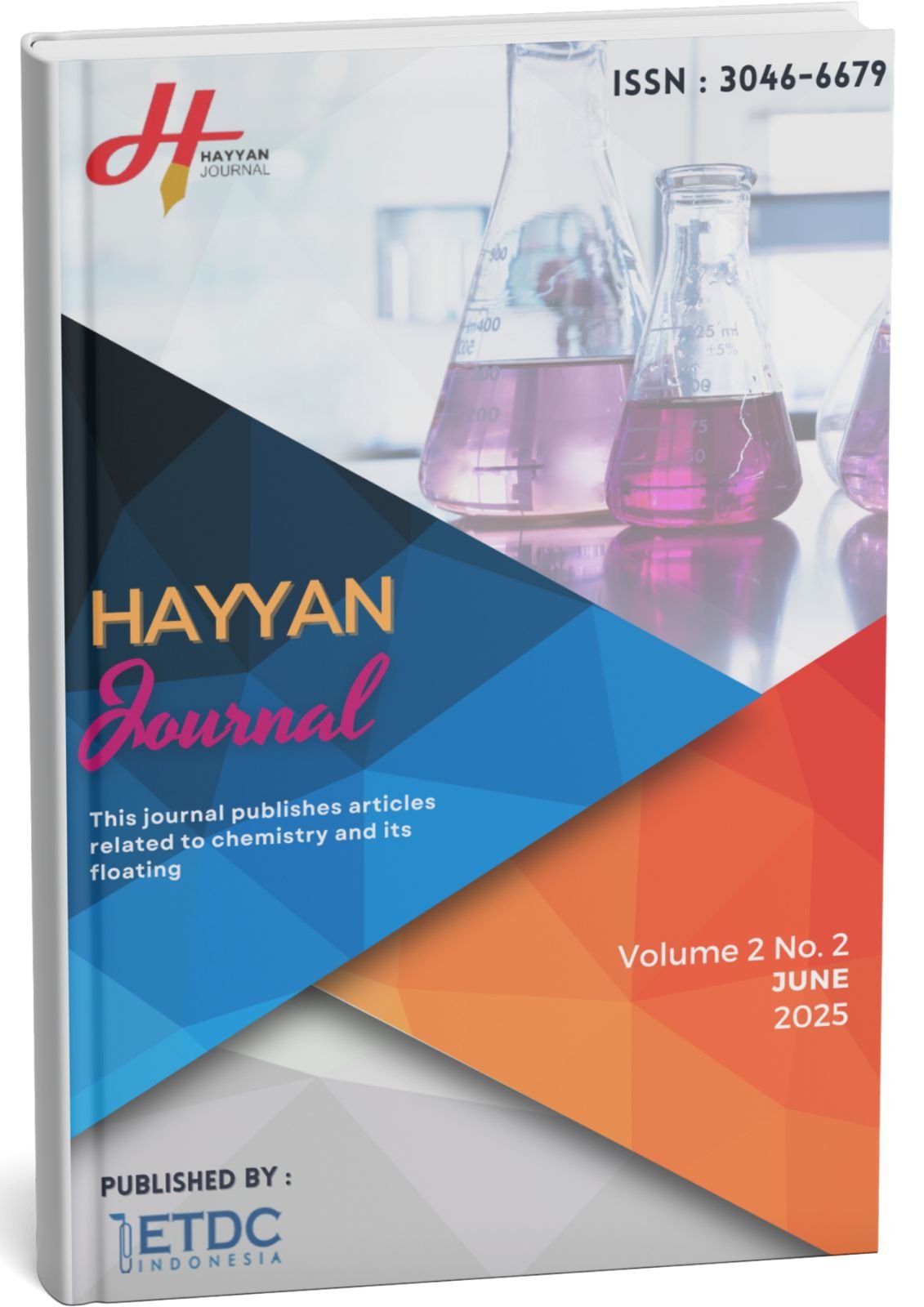Abundance of Endophytic Bacteria in Sauropus androgynus and Evaluation of Chitinolytic Activity
DOI:
https://doi.org/10.51574/hayyan.v2i2.3175Keywords:
Keywords: Endophytic Bacteria, Chitinolytic, Plant PathogenAbstract
This study aimed to isolate and evaluate the biological safety and potential of endophytic bacteria from Sauropus androgynus (katuk) and their Chitinolytic activity for use as biological agents. A total of 14 endophytic bacterial isolates were obtained from different plant parts: 5 from the roots (T1, T2, T3, T4, P14), 5 from the stems (T7, T8, T9, T10, T11), and 4 from the leaves (T5, P6, KB12, T13). The safety of these isolates was assessed through hypersensitivity (HR) and hemolysis (HL) tests. In the HR test, none of the isolates induced necrotic symptoms in tobacco leaves, indicating they are not pathogenic to plants. In the HL test, two bacterial which were T4 from roots and T5 from leaves, isolates were found to produce clear zones on blood agar, indicating α-hemolysin production. However, the other isolates did not form hemolysis zones, suggesting they are safe for mammals. Antibacterial activity against the plant pathogen Ralstonia solanacearum was evaluated using spot inoculation methods. The results showed that none of the isolates were able to inhibit the growth of R. solanacearum. Further testing revealed that one bacterial isolate which was T8 obtained from the stem produced chitinase, as evidenced by the formation of a clear zone around the bacterial colony on chitin-containing media.
References
Agrios GN. 2005. Plant Pathology. 5rd ed. London (GB): Elsevier Academic.
Bacon CW, Hinton DM. 2007. Bacterial Endophytes: the Endophytic Niche, its Occupants, and its Utility. Berlin (DE): Springer.
Compant S, Duffy B, Nowak J, Clement C, Barka EA. 2005. Use of plant growthpromoting bacteria for biocontrol of plant diseases: principles, mechanism of action, and future prospect. Appl Environ Microbiol. 71(9):4951–4959.
Fatimah S, Yuliana P, Aris M. 2010. Efektifitas Ekstrak Daun Katuk (Sauropus Androgynus L.) Dalam Menghambat Pertumbuhan Bakteri Staphylococcus Aureus Secara In Vitro ipi179205. Stikes Guna Bangsa, Yogyakarta.
Hariprasad P, Divakara S, Niranjana S. 2011. Isolation and characterization of chitinolytic Rhizobacteria for the management of Fusarium Wilt in Tomato. Crop Protection. 30(12):1606-1612.doi: 10.1016/j.cropro. 2011.02.032.
Klement Z. 1982. Hypersensitivity defense reaction of plants to pathogens. Annual Review Phytopatology. 5(3):17-44.doi:10.1146/annurev.py.05.0 90167.000313.
Khusnan, Oktavia S, Soegiyono. 2008. Isolation and phenotipical characterization of Staphylococcus aureus isolated from slaughtered house waste and carcass of chicken. Jurnal Veteriner 9(1):45-51.
Klement Z, Rudolph K, Sands D. 1990. Methods In Phytobacteriology. Hungaria (HU): Akademia Kiado.
Koomnok C, Teaumroong N, Rerkasem B, Lumyong S. 2007. Diazotrop endophytic bacteria in cultivated and wild rice in Thailand. Science Asia 33: 429-435.
Lamb TG, Tonkyn DW, Kluepfel DA. 1996. Movement of Pseudomonas aureofaciens from the rhizosphere to aerial plant tissue. Can. J.Microbiol. 42:1112–1120.
Munif A, Hallmann J, Sikora RA. 2013. The influence of endophytic bacteria on Meloidogyne incognita infection and tomato plant growth. Journal International Society for Southeast Asian Agricultural Sciences 19(2):68- 74.
Munif A, Sulistiawati I. 2014. Pengelolaan penyakit kuning pada tanaman lada oleh petani di wilayah Bangka. Jurnal Fitopatologi Indonesia. 10(1):8-16.doi: 10.14692/jfi.10.1.8.
Oktafiyanto M.F. The Potential of Endophytic Bacteria from Mangrove Plants as a Biocontrol Agent Against Ralstonia solanacearum and Meloidogyne spp. in Tomato Plants. Repository IPB. Diakses pada 29 Juni 2018.
Pratiwi RS, Susanto TE, Sutrisno A. 2014. Enzim kitinase dan aplikasi di bidang industri. Jurnal Pangan dan Agroindustri 3(3):878-887.
Salasia SIO, Khusnan Z, Lammler C, Zschock M. 2004. Comparative studies on pheno-and genotypic properties of Staphylococcus aureus isolated from bovine subclinical mastitis in Central Java in Indonesia and Hesse in Germany. Journal of Veterinary Science (2):103-109.
Schulz B, Boyle C. 2006. What Are Endophytes. Berlin (DE): Springer.


